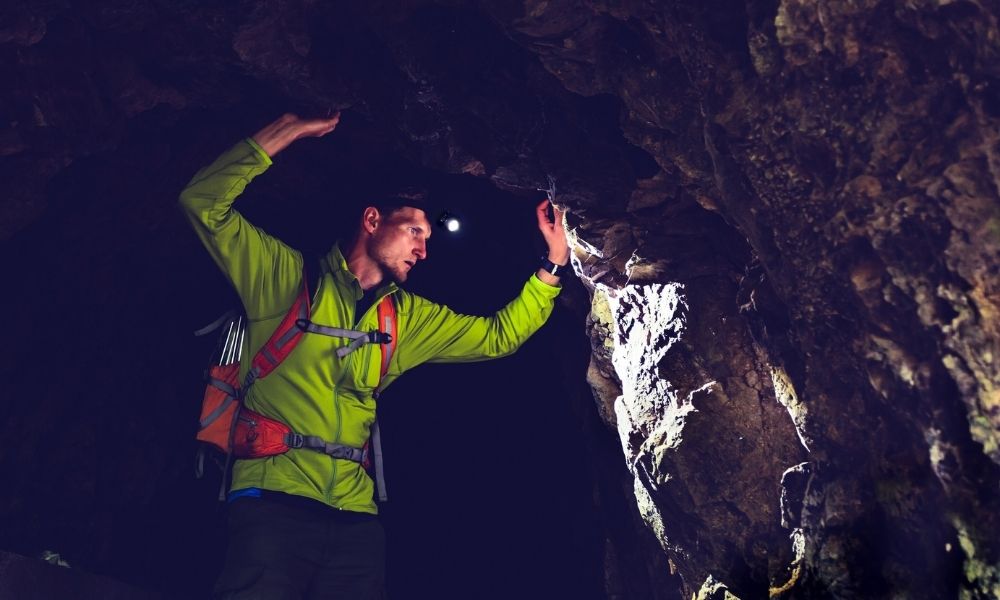
Whether you're camping, hiking, or performing a vital mission, having a reliable source of illumination to guide you through dim-lit spaces is a must. A flashlight works, but it takes up valuable space in your hands. A hands-free alternative to flashlights, headlamps, are one of the best ways to navigate in the dark. Modern headlamps use LEDs as their primary light source. LEDs are rugged, energy-efficient, and long-lasting, making the headlamps that use them sturdy and dependable. You won't have to worry about brightness levels, dropping and breaking your headlamp, or the batteries unexpectedly running out. While headlamps share the same general qualities, they come with a variety of different features. So, what sets one headlamp apart from the next? How do you know what to buy? This guide on how to choose the right headlamp will help you find the perfect fit.
Beam Type
Beams come in two main types: flood and spot. Each type has its own unique benefits. A flood, or wide beam, is used for general tasks, up-close repair work, and reading. Flood beams won't throw light a long distance, which makes them less suitable for navigating the wilderness or long, winding paths. A spot beam, also known as a focused or narrow beam, enables long-distance viewing. It's the best beam type for navigating in the dark. Whether you opt for a flood beam or spot beam, adjustable headlamps are one of the most versatile options.
Light Output (Lumens)
Lumens are a unit of measure that gauges the total quantity of light emitted in all directions by a light source. A light with a higher lumen count will consume more energy. So, does a higher lumen count equate to brightness? Yes, but not always. The way a headlamp focuses and directs light can impact how well its lumens are utilized. Headlamps can range from 15 to 500+ lumens. Headlamps at the lower end of the lumen range are great for use at campsites, while the other end of the range is ideal for caving, climbing, or other intense situations.
Beam Distance
A headlamp is designed to channel light to a specific target area. Before they're put on the market, headlamps are tested to determine how far (in meters) they can project usable light. The number of lumens will tell you how brightly a headlamp glows, while beam distance will tell you how far that brightness goes.
Run Time
A headlamp's run time gives you a sense of how long your equipment will last on a single charge. In recent years, the headlamp industry has adjusted the way run time is measured. Originally, manufacturers measured run time until a headlamp failed to produce usable light at 2 meters. The new standard uses 10% of a light's original brightness as the point where run time ends. Under the old standard, a 350-lumen headlamp would have lasted 40 hours. When tested under the new standard, it's run time is reduced to 2 hours. The headlamp will still provide an additional 38 hours of illumination, but it won't be as bright. If two similar headlamps are listed with a major difference in run time, one might not have been tested under newer standards.
Weight
Unless you're looking at high-powered models, you shouldn't have to worry much about size and weight. Most headlamps weigh less than 7 ounces and differ only slightly in size. Some models have top straps, external battery packs, and other features that can contribute to bulk. These headlamps are designed for specific needs—climbing, for example—instead of simple, routine tasks.
Brightness Levels and Modes
Most headlamps will offer a high mode and a low mode. Others might offer up to three or more additional modes. Strobe, also known as flash mode, acts as an emergency blinker. Some models will offer a choice of flash rates: slow and fast. Low is the standard mode. It's used for simple tasks, like camp chores or walking along a short, straightforward path. Mid, like its name suggests, provides a middle ground between low power and high power. High is a good option for situations where you need or want more light.
Additional Features
Another tip on how to choose the right headlamp is to check out the additional features it comes with. Let's look at some of the most common and most useful add-ons.
Regulated Output
The light on a regular headlamp will steadily diminish as the batteries drain. Regulated headlamps, on the other hand, offer a steady brightness level throughout the batteries' life. There's one minor downside to regulated output: when the batteries are exhausted, a regulated headlamp will abruptly shut off. This can leave you scrambling for spare batteries in the dark, which isn't ideal. The dimming light in a regular headlamp gives you an early warning of failure.
Red Light Mode
Most headlamps offer a red-light mode. Since red light doesn't cause our pupils to shrink in the same way white light does, it’s beneficial for nighttime use.
Water Resistance
Most high-quality headlamps can withstand some degree of exposure to rain and snow. A few can handle shallow, short-term immersion. For headlamps, waterproof standards come in the form of IPX ratings. IP stands for "Ingress Protection" and the X tells the user that there's no dust rating. IPX-0 means that the headlamp's housing isn't protective, and not water-resistant at all. Most headlamps offer protection in the IPX-4 to IPX-7 range, which is on the higher, more durable end of the spectrum.
Tilt
The ability to adjust your headlamp gives you greater freedom, allowing you to position the beam exactly where you want it. If you're reading under the light of a headlamp, this is an especially great feature.
Batteries
Headlamps designed for use with lithium batteries are perfect for cold-weather usage, since lithium batteries outperform alkaline batteries in cold conditions. Rechargeable nickel-metal hydride, or NiMH batteries, also work well with headlamps. Regardless of what you choose, you should always carry a few alkaline batteries, which are great at holding their charge, as spares.
Looking for sturdy, powerful headlamps? Search and Recovery Engineering has what you need. We carry a wide variety of safety products, including recovery ropes and Nitecore headlamps. Come check out our impressive selection of supplies and equipment today!




